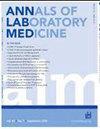体外诊断认证肌酐测定在韩国超过7年:成就和未来展望
IF 3.9
2区 医学
Q1 MEDICAL LABORATORY TECHNOLOGY
引用次数: 0
摘要
背景:肌酸酐(Cr)缺乏国际参考测量实验室网络;因此,韩国建立了独立的评价和认证体系。体外诊断(IVD)认证计划于2017年启动,是旨在提高制造阶段准确性的更广泛的Cr标准化计划的一部分。方法该程序设计用于评估分析系统,包括所有试剂批次、校准器和仪器型号,每年两次。偏差、不精确、总误差(TE)和线性根据既定的接受标准进行评估。认证后流程允许提交第二次质疑和纠正措施的验证。结果2017 - 2023年共对489套分析系统进行了评价。偏差、不精确、TE和线性的平均接受率分别为70.8%、95.9%、87.7%和87.8%。2018年无补偿动力学Jaffe法的偏倚评估接受率最低,为8.7%。7年期间,平均绝对偏差百分比(absBias%)、变异系数(CV)和TE分别为4.62%、1.37%和7.29%。在0.0≤Cr < 1.0目标值范围内,abbias %最高(7.94%)。自2019年以来,观察到abbias %持续下降。结论:该项目是对缺乏Cr检测全球认证项目的开创性回应。它具有显著的优势,包括全面的评估、免费参与和健全的认证后流程。制造商的持续参与和改进努力有助于提高铬测定的准确性。本文章由计算机程序翻译,如有差异,请以英文原文为准。
In Vitro Diagnostics Certification for Creatinine Assays in Korea over 7 Years: Achievements and Future Outlook.
Background
An international reference measurement laboratory network for creatinine (Cr) is lacking; therefore, Korea developed an independent evaluation and certification system. The in vitro diagnostics (IVD) certification program, launched in 2017, formed part of a broader Cr standardization initiative intended to enhance accuracy at the manufacturing stage.
Methods
The program was designed to evaluate analytical systems, including all reagent lots, calibrators, and instrument models, twice annually. Bias, imprecision, total error (TE), and linearity were evaluated based on established acceptance criteria. A post-certification process allows submission for a second challenge and validation of corrective actions.
Results
Between 2017 and 2023, 489 analytical systems were evaluated. Average acceptance rates for bias, imprecision, TE, and linearity were 70.8%, 95.9%, 87.7%, and 87.8%, respectively. The lowest acceptance rate for bias evaluation was 8.7% for the kinetic Jaffe method without compensation in 2018. Over the 7-year period, the mean absolute percentage bias (absBias%), coefficient of variation (CV), and TE were 4.62%, 1.37%, and 7.29%, respectively. The highest absBias% (7.94%) was observed in the 0.0 ≤ Cr < 1.0 target value range. Since 2019, a consistent reduction in absBias% has been observed.
Conclusions
This program is a pioneering response to the absence of a global certification program for Cr assays. It offers significant advantages, including comprehensive evaluations, fee-free participation, and a robust post-certification process. Continuous participation and improvement efforts by manufacturers have contributed to enhanced accuracy in Cr assays.
求助全文
通过发布文献求助,成功后即可免费获取论文全文。
去求助
来源期刊

Annals of Laboratory Medicine
MEDICAL LABORATORY TECHNOLOGY-
CiteScore
8.30
自引率
12.20%
发文量
100
审稿时长
6-12 weeks
期刊介绍:
Annals of Laboratory Medicine is the official journal of Korean Society for Laboratory Medicine. The journal title has been recently changed from the Korean Journal of Laboratory Medicine (ISSN, 1598-6535) from the January issue of 2012. The JCR 2017 Impact factor of Ann Lab Med was 1.916.
 求助内容:
求助内容: 应助结果提醒方式:
应助结果提醒方式:


